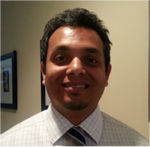|
Dance and a "Talent for Unconscious Entrainment"
What is happening in that mysterious space between people who discover they have fine interpersonal chemistry?
 Suzanne Dikker, a cognitive neuroscientist at New York University, hopes dancing holds clues. She is using dance to investigate human brainwave synchronization and learn how it can happen. "NeuroTango" was hosted recently by the Greater New York City Chapter of the Society for Neuroscience as part of its Brain Awareness Week. It was also an opportunity for Dikker to get pairs of tango dancers to wear EEG headsets to measure their brain waves as they danced and thought about dancing. A Scientist.com story by Eli Chen describes Dikker's experiment. Suzanne Dikker, a cognitive neuroscientist at New York University, hopes dancing holds clues. She is using dance to investigate human brainwave synchronization and learn how it can happen. "NeuroTango" was hosted recently by the Greater New York City Chapter of the Society for Neuroscience as part of its Brain Awareness Week. It was also an opportunity for Dikker to get pairs of tango dancers to wear EEG headsets to measure their brain waves as they danced and thought about dancing. A Scientist.com story by Eli Chen describes Dikker's experiment.
Couples who were experienced dancing partners danced to music as they usually would. They then switched partners, so they were dancing with a new partner or someone less familiar. Next, they stood still with their original partners and imagined dancing. Dikker projected graphics onto the walls, showing when dancers' brains were in sync, and not. Other studies have shown that experienced dancers coordinate their movement differently from novices, and that both dancing and mentally rehearsing the dance stimulate similar brain activity.
Dikker said she is using the tango because the dancers perform fast, intricate movements that require exceptional coordination and the need to anticipate each other's every step, sway and twirl. In addition, leaders and followers have different mental tasks. She also hopes to learn whether the EEG can reliably measure brain activities of people who are moving. The Scientist story says Dikker had worked with Marina Abramovic on "Measuring the Magic of Mutual Gaze," at the Garage Center for Contemporary Culture in Moscow in 2011. In that event, designed to examine empathy and nonverbal communication, Amramovic and volunteers sitting opposite her gazed into each other's eyes while EEG headsets captured their brain activities. In that case, the subjects were stationary.
Lawrence Parsons, a cognitive neuroscientist at the University of Sheffield, did a neuroimaging study of dancers in 2008. An article he co-authored for the Scientific American says coordinated dancing may not occur anywhere in the animal kingdom except among humans. "Our talent for unconscious entrainment lies at the core of dance, a confluence of movement, rhythm and gestural representation," the article says. "By far the most synchronized group practice, dance demands a type of interpersonal coordination in space and time that is almost nonexistent in other social contexts."
Lewis Hou, a research associate at the University of Edinburgh, is studying what happens in the brains of Scottish folk dancers as they perform. He praises NeuroTango as excellent science communication and a good way to engage the public in neuroscience. Hou will be participating in a science festival this April in Edinburgh where the dance performances will be partnered with scientific explorations.
O body swayed to music, O brightening glance,
How can we know the dancer from the dance?
From "Among School Children" by William Butler Yeats
Liberating Structures Workshop
May 29-30 - Washington, DC
Register

Smart leaders know that they would greatly increase productivity and innovation if only they could get everyone fully engaged. The challenge is how. Liberating Structures are novel, practical and effective methods to help you accomplish this goal with groups of any size. During this roll-up-your-sleeves immersion workshop, participants will learn and immediately practice 10-12 Liberating Structures while receiving tips on how to implement them in the workplace and traps to avoid. Event flyer (pdf). 1-day, $150. 1 1/2-day, $200. Attendance limited to 100. ebook now available!
"Liberating Structures were the critical tools I was missing. When using them, I have been surprised by the results (in all positive ways) and challenged by what I have discovered from them. They are transforming my classroom and work. It is now painful for me to sit through a traditional meeting or lecture-style class. I know how much more useful our time could be spent together if a Liberating Structure was used instead." from amazon.com review by Marie Lindquist, Clinton School of Public Service
Leading Adaptive Change Healthcare Workshop
May 5-7 - Philadelphia, PA
Register
Please join us on May 5-7 in Philadelphia for a new workshop, Leading Adaptive Change, and leave with approaches for engaging your organization to tackle stubborn challenges in patient safety. Too often, patient safety and quality improvement efforts fail because they focus on technical changes-such as introducing new tools and technologies-without addressing the values, beliefs and attitudes of the group involved in the work. This three-day program provides participants with concrete methods and tools for adaptive change. From our friends at Cheasapeake Bay Organization Development Network:
CBODN's upcoming conference is scheduled for May 1-3 in the Washington, D.C., area. This year's theme is "Building Innovation in Organizations," and we are excited to be planning an expanded, three-day event filled with collaboration, networking, education and outreach! Early bird pricing ends Monday. Additional information about the conference is online at http://cbodn.org/2014conference/.
Remember PlexusCalls!
PlexusCalls
Friday, April 25, 2014- 1-2 PM ET
Mentoring Military Women
Guests: Healther Gunther, Michelle Alexander, and Lisa Kimball
The U.S. Army is making more positions gender neutral, but women are still a minority in the rank and file and an even smaller minority in leadership. The new Women's Mentorship Network (WMN) at Fort Hood, Texas, is designed to cultivate capable, resilient and confident women leaders who will enrich the armed forces with their abilities as new leadership opportunities arise.
Heather Gunther, one of the creators of the new network, is an active duty Army Signal Corps officer assigned to 3d Armored Brigade Combat Team, 1st Cavalry Division at Fort Hood Texas. She was commissioned from West Point in 2002 and has served with the 1st Infantry Division and the 7th Signal Brigade in Tikrit, Iraq and at Mannheim, Germany. Heather holds a B.S. from the United Stated Military Academy, an M.S. in Information Technology, and is currently working on a doctoral thesis on women in the military.
Michelle Alderson, A WMN colleague, is an active duty Medical Service Corps officer assigned to the 3d Armored Brigade Combat Team, 1st Cavalry Division at Fort Hood, Texas. Michelle graduated from West Point in 2009, where she earned her commission and a lifelong passion for lifesaving. Michelle served with the 1st Cavalry Division during a yearlong combat tour to Maysan, Iraq. Her experiences with battlefield trauma and emergency medicine have inspired her to become a physician. Michelle will attend medical school starting this August.
Lisa Kimball, PhD is an entrepreneur with more than 30 years experience as an organizational consultant with business, government and nonprofit organizations. As CEO of Metasystems Design Group and Executive Producer of Group Jazz, she supported the efforts of teams, task forces, communities and organizations and helps them leverage the power of technology and social media. Before coming to Fort Hood, Major Gunther had been at the Army's general staff college at Fort Leavenworth. While there, she participated in a 2011 leadership development program with Ori Brafman, the author of The Starfish and the Spider. a book about successful organizations that are decentralized and adaptive. She also met Lisa Kimball, and later conferred with Lisa and Ori about the WMN. Heather and her colleagues decided to infuse the new venture with some of the processes and practices that had inspired participants in the groups at Fort Leavenworth.
Healthcare PlexusCalls
Wednesday, April 16, 2014- 1-2 PM ET
Clinical Pharmacists as Internal Change Agents
Guest: Rohit Moghe
For many laymen, clinical pharmacists are "the wizards behind the screen," much of their work invisible to the public eye. In hospitals, clinical pharmacists collaborate with physicians and other healthcare professionals, while working directly with patients. They not only round on various medical teams, but also provide various consultative services. In outpatient settings such as clinics and infusion centers (chemotherapy, biologics), patients often interact with the clinical pharmacist, who may fill a role in chronic disease management similar to nurse practitioners and physician assistants, helping the patient manage his or her condition. With their medication expertise, they are crucial in promoting safe, rational, evidence-based use of medications, impact medication adherence, and provide insight into quality of care and outcomes through research.

Rohit Moghe, PharmD, MPH, is an advanced practice pharmacist and a certified diabetes educator with a passion for public health. He received his bachelor's in biology at Penn State University, Doctor of Pharmacy from University of Illinois-Chicago, and Masters of Science in Public Health from Thomas Jefferson University. He currently works at Thomas Jefferson University Hospital, a large, urban teaching university hospital. He is involved in various activities throughout the organization including patient care, patient education, staff development, research, medication use policy, drug therapy surveillance, population management, and health care technology.
Audio from all PlexusCall series is available by searching the iTunes store for plexuscalls. Or, visit plexusinstitute.org under Resources/Call Series.
|